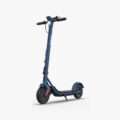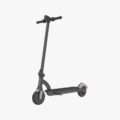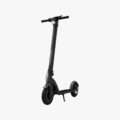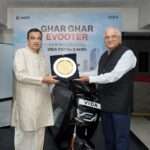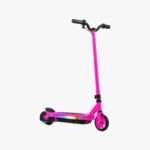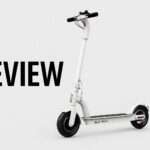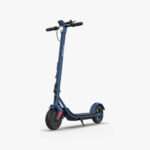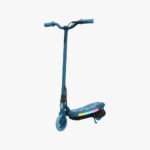- Home
- Scooters
- Electric Scooters
- Jetson Relay
Jetson Relay
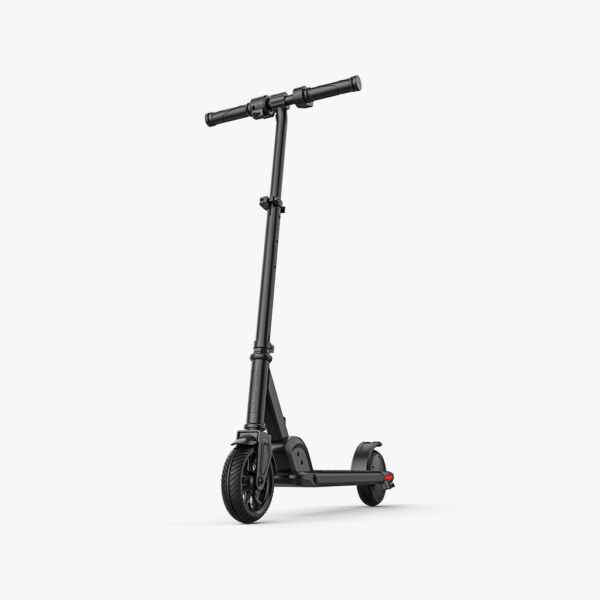

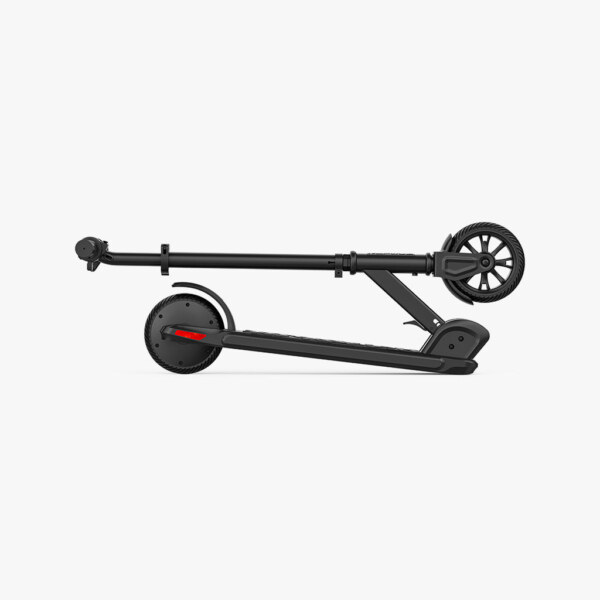
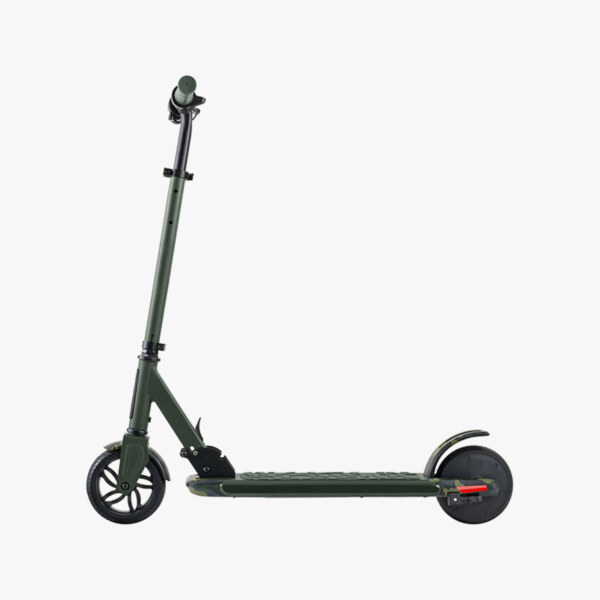
- Battery Range: 5 miles (8 km)
- Top Speed: 10 mph (16 km/h)
- Motor Power: 100 W
- Weight Capacity: 120 lb (54.4 kg)
- Charging Time: ~Up to 5 h
- Scooter Weight: 15.5 lb (7.0 kg)
PROS
- 3 speed modes 5. 8. 10 mph
- Adjustable 32.6–37.5 in handlebar
- Folded size 29.5 × 15.3 × 10.4 in
- Dual braking. e-brake + foot
- Lightweight 15.5 lb
CONS
- Short 5 mile range
- No app or cruise control
- IP rating not specified

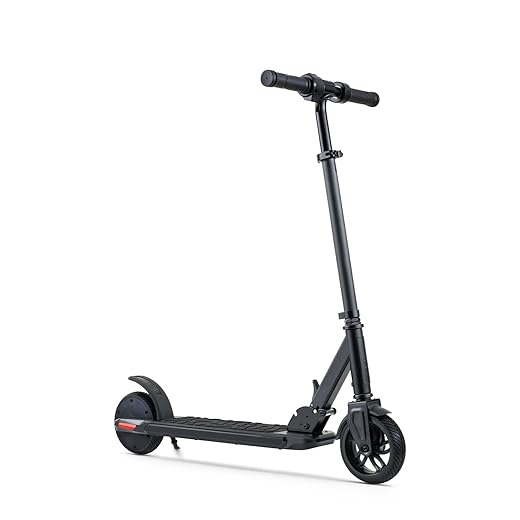
The Jetson Relay is a small, simple kids’ electric scooter for real everyday fun. It works best for young riders who stay on short, safe routes close to home. Parents get clear speed limits and easy controls. Kids get that “real scooter” feeling without scary speeds.
What Is the Jetson Relay?
The Jetson Relay is a lightweight electric scooter built for children around eight years and up. It supports riders up to 120 lb, or about 54.4 kg. The setup stays simple. There is a rear hub motor, a lithium-ion battery inside the deck, an adjustable handlebar, and an easy folding stem.
Top speed reaches about 10 mph, or 16.1 km/h, in the highest mode. Two lower modes hold speeds near 5 mph and 8 mph. So parents can match the scooter to skill level instead of going straight to max speed. This structure turns it into a learning scooter, not just a fast toy.
The wheels measure 6 in, or about 15.2 cm. So it likes smooth sidewalks, park paths, and clean driveway concrete. The deck length gives space for a natural stance. One foot near the front, one near the rear fender. The low deck height helps balance and makes stepping off feel natural.
Total weight sits near 15.5 lb, or about 7.0 kg. That number keeps it friendly to carry up stairs or into a car trunk. Then the fold helps it slip under a desk, into a closet, or near an entry without taking over the room.
How the Jetson Relay Works
The Jetson Relay runs a 100 W brushless hub motor placed inside the rear wheel. Power goes straight to the tire with no chain and no exposed drivetrain parts. So rides stay quiet and clean. From a small push start, the motor adds a steady pull that feels smooth, not jumpy.
Inside the deck, a compact controller reads the thumb throttle signal. Then it feeds power to the motor based on the chosen mode. A small display and a mode button on the handlebar show speed level and battery bars. Kids understand it after a short walk-through. Parents can glance down and check settings in a second.
The battery is a 21.9 V, 2.6 Ah lithium-ion pack tucked in the deck. That pack suits short loops and play sessions. A dedicated charger plugs into a port on the frame. A full charge from low runs up to about five hours. So most families plug it after rides and find it ready next day.
Control remains straightforward. The right thumb presses the throttle paddle. The left hand pulls a lever that commands the electronic brake in the rear wheel. The rear fender works as a foot brake backup. Kids learn a simple pattern. Look ahead, ease off the throttle early, pull the lever, then use the fender if needed.
Key Specifications
| Block | Details |
|---|---|
| General | Target rider age: about 8+ years. Max rider weight: 120 lb (54.4 kg). Scooter weight: 15.5 lb (7.0 kg). Best for paved, smooth surfaces. |
| Performance & Power | Motor: 100 W rear hub. Top speed: 10 mph (16.1 km/h). Three modes: about 5, 8, 10 mph. Wheel size: 6 in (15.2 cm). Short mild hill use only. |
| Battery, Charging & Electrical | Battery: 21.9 V, 2.6 Ah lithium-ion. Stated range: up to 5 mi (8 km) in light use. Charge time: up to 5 hours. Simple display with mode and battery icons. |
| Build & Dimensions | Unfolded: about 32 × 15.3 × 37.5 in (81.3 × 38.9 × 95.3 cm). Folded: about 29.5 × 15.3 × 10.4 in (74.9 × 38.9 × 26.4 cm). Deck: about 23.6 × 4.8 in (60 × 12.2 cm). Height-adjustable bar. Kickstand included. |
| Safety & Control | Electronic rear brake via hand lever. Rear foot fender brake. Reflective elements. Daytime use recommended. |
| Features & Extras | Three learning-friendly modes. Quick fold. Adjustable handlebar. No Cruise Control. |
| Warranty & Compliance | 180-day limited warranty from Jetson. Built to standard electronic safety and compliance norms. |
These specifications come from official data and frame the Jetson Relay as a true kid-focused scooter.
Design & Build Quality
The design looks clean and familiar, which helps kids trust it fast. The alloy frame and molded parts aim to stay light but still feel solid when you pick it up. The stem folds at the base with a simple latch. Then it locks upright with a clear click, so you know it is ready.
The deck sits low. So kids step on without a climb and stand closer to the ground. That lower stance helps balance at slow speeds and makes quick step-offs easier. Grip on the deck surface holds sneakers without feeling sticky. Edges stay smooth, so there is less risk of scraped ankles.
The cockpit is compact. The thumb throttle sits close to the right grip. The brake lever hugs the left grip. A small display and mode button sit in the center. So little hands reach every control without stretching. That layout keeps focus on riding, not on hunting for buttons.
Cables route tight to the frame. The charging port has a rubber cover that closes with a clear push. Bolts sit neat and do not catch clothing. Is it perfect. No. Sometimes a latch feels a bit stiff or a sticker line sits a touch off, yet the overall build matches its role and price.
Performance Fundamentals
The Jetson Relay favors calm, clear behavior. In mode one, starts feel slow and safe. So new riders can practice control without pressure. They learn to stand steady, look ahead, and steer smooth.
Switch to mode two and speed rises enough for a bit more fun. The scooter still feels tame, yet it covers ground faster. Kids who already ride kick scooters adapt to this stage quickly. Parents see if they brake on time and hold their line.
Mode three unlocks that 10 mph cap on flat ground with a lighter rider. The 100 W motor does not snap forward. It rolls up to speed in a predictable way. So riders have time to adjust. On mild grades, pace drops. On steeper driveways or longer ramps, the scooter slows and may come near a crawl. That behavior matches its role as a flat-area scooter, not a hill machine.
Steering feels light. The short wheelbase and narrow deck let kids turn in a tight space. If they jerk the bar, the front can feel twitchy at top mode. So parking-lot training helps. A few laps in an open space smooth out inputs and remove wobbles.
Battery, Range & Efficiency
The battery pack is small on purpose. It keeps weight down and matches short neighborhood rides. Official range reaches about 5 mi, or 8 km, under gentle use with a lighter rider on flat pavement.
Real numbers change with rider weight, terrain, and riding style. A child near half the weight limit, riding in lower modes on smooth paths, can get close to the stated figure. A rider near 120 lb who runs top mode on rougher ground will see less distance. So plan for shorter loops and leave some charge in reserve.
Temperature matters as well. Warm, mild days bring better range. Cold days cut it. For most families, a practical plan looks simple. Aim for 2–3 mi of use, then charge. That habit avoids deep drains and keeps the pack healthier over time.
Charging stays low effort. Roll the scooter inside, let it rest a short moment, and plug in the dedicated charger. A full top-up from near empty takes several hours. Then unplug once full. No menu, no app, no fuss.
Ride Quality & Comfort
On smooth pavement, ride feel is pleasant and stable. The small wheels track straight at low and medium speeds. So kids focus on steering and scanning ahead instead of fighting the scooter.
On cracked asphalt, bricks, or patchy sidewalks, harsh bumps pass through more. The deck has no built-in suspension. The fix is simple and human. Tell the rider to slow down, bend knees a bit, and roll light over rough patches. That body movement does more than any small entry-level spring could do here.
The deck size gives enough room for a proper stance. Front foot points ahead. Rear foot across the deck near the fender. That stance keeps weight near the rear wheel, which helps grip under braking. The adjustable bar lets you match height to the rider. Set it around hip to low waist height. Then elbows stay soft, and steering feels natural.
With a tight latch and checked bolts, stem flex stays minimal in this use case. If you ever feel extra play, pause riding and tighten. It takes only a moment.
Braking & Safety Features
The braking layout makes sense for kids. The hand lever controls the electronic brake in the rear wheel. Pull light for a gentle slow. Pull more for stronger stop. The feel comes in a smooth ramp. So it teaches progress, not panic.
The rear fender brake is there as a backup and as a habit from kick scooters. A heel press adds friction on the rear wheel. It works well at low speeds near walking pace. Practice both. Start in an empty lot. Roll, ease off the throttle, pull the lever, then touch the fender. Short, simple drills lock this in.
Reflective details help a bit in low light, yet the scooter lives best in daytime use. Bright helmets and normal safe gear add far more than any small reflector. Local rules differ by city and country. Check age limits, sidewalk rules, and safety rules before regular rides.
One more practical note. The Jetson Relay does not claim strong water protection. So keep it away from puddles, soaked streets, and heavy rain.
Portability & Daily Usability
For real daily life, the size and weight feel friendly. Carrying 15.5 lb up a few steps or into a car trunk is no big deal for most adults. Kids can help line it up or lift one end. So it never feels like a burden.
The fold is quick. Flip the latch, drop the stem, lock it in place. Then the scooter forms a compact shape around 29.5 in long. That fits in small trunks, next to a shoe rack, or between furniture. The kickstand keeps it upright when unfolded, which is handy in garages and halls.
Short prep steps before rides add to usability. Check the latch, check the charge, tap the mode. Then ride. No pairing, no user account, no complex setup. That light routine fits families who want riding, not tinkering.
Security stays basic. The scooter is small and easy to pick up. So treat it like a kid’s bike. Store indoors or in a locked spot, not loose at the curb.
Maintenance & Care
A simple checklist covers most care and keeps the scooter safe.
Before each ride
- Check folding latch and stem clamp.
- Confirm handlebar height lock is tight.
- Squeeze the brake lever, then spin the rear wheel by hand.
- Look for cracks in the deck or loose parts around the fender.
- Check wheels for damage or stuck stones.
Weekly
- Wipe the frame, deck, and bar with a soft damp cloth.
- Check the charging port cover, make sure it closes right.
- Test throttle and brake response in a short straight run.
- Check the kickstand bolt.
Monthly
- Go over visible screws with the correct hex key.
- Check the fold joint for play. Tighten if needed.
- Inspect reflectors and decals.
- Run a simple stop test from medium speed and confirm stable, repeatable braking.
Battery care tips
- Store indoors at a steady room temperature.
- Avoid long storage at empty level. Keep some charge.
- Charge after rides instead of waiting many days.
- Use only the correct Jetson Relay charger.
These habits take a few minutes and keep both rider and scooter in better shape.
Weather & Seasonal Considerations
Dry pavement is where this scooter feels right. Water on the ground cuts grip for small wheels. So avoid rides in rain or through puddles. If weather changes mid-ride, stop in a safe spot and walk.
Cold days shorten range. On near-freezing mornings, plan shorter sessions and bring the scooter back inside soon. Hot days stress batteries if storage sits in direct sun or closed cars. So pick a shaded indoor corner for parking.
Loose gravel, wet leaves, sand, and painted lines in rain all raise risk. Teach riders to slow before these and keep the scooter upright when crossing. Big cracks, deep potholes, and curbs stay off limits. That advice sounds strict, yet it keeps kids upright.
Jetson Relay vs Alternatives
The Jetson Relay sits in a clear lane. It is a starter electric scooter for kids, not a full commuter, not a stunt rig.
Adult commuter scooters bring larger motors, bigger batteries, and higher top speeds. They carry more weight and feel stronger, yet they also feel heavier and taller for kids. So they fit teens and adults, not smaller riders.
Performance scooters push power, range, and features even harder. Those rigs pack dual motors, strong hydraulic brakes, and chunky frames. They land in a very different class that does not match the needs of an eight-year-old.
Off-road models bring knobby tires and suspension. They like dirt paths, roots, and rocks. The Jetson Relay likes flat concrete and calm streets near home instead. That honest match between design and use is part of its appeal.
If you want more reach or speed for older riders one day, you can look at bigger models on your shortlist, like a Jetson Racer style device or a compact commuter similar to the Jetson Eris. For now, the Relay aims at that first safe step.
Who the Jetson Relay Is (and Is not) For
A strong fit for
- Kids around eight or older who stay under 120 lb.
- Parents who want clear mode limits and simple controls.
- Short neighborhood loops, smooth sidewalks, park paths, and driveway play.
- Families that drive to safe spots and want a scooter that folds into the trunk.
Not a match for
- Riders above the listed weight.
- Daily long commutes with many hills.
- Rough pavement, gravel, grass, or curb-hopping.
- Regular rain rides or wet climates without dry-day options.
Used as a training scooter with clear rules, the Jetson Relay does its job well. Set the slow mode first. Walk through throttle and braking. Ride in open spots before mixing with any busy area. The setup is simple, the weight is low, and kids gain skills they can carry to bigger scooters later.
Specifications
General
| Model The Model specifies the exact version or name of the scooter. It helps identify its unique design, features, and specifications within the manufacturer’s product line. Knowing the model makes it easier to compare options, find compatible accessories, or look up support information. | Relay |
| Brand The Brand identifies the manufacturer or company that designs and produces the scooter. A trusted brand is a sign of quality, reliability, and good customer support. Well-known brands often have higher standards for safety, performance, and after-sales service, giving you more confidence in your purchase. | Jetson |
| Release Date The Release Date indicates when the scooter model was officially launched on the market. This helps you know how current the design, technology, and features are. A newer release date often means updated components, improved performance, and the latest safety or smart features. | 18 November 2025 |
| Recommended Age Recommended Age indicates the minimum age range that the scooter is designed for, based on safety, size, and ease of use. Following the recommended age helps ensure that riders can handle the scooter’s speed, weight, and controls comfortably and safely. Always check local laws and use protective gear, especially for younger riders. | 8+ |
Performance & Power
| Motor Power (Wattage) What it means: The motor power, measured in watts (W), shows how strong the scooter’s electric motor is. Why it matters: Higher wattage usually means better acceleration, more torque, and improved performance on hills or rough terrain. For example, a 250W motor is good for flat city roads and light riders, while a 500W or 1000W motor provides more power for faster speeds or climbing steep inclines. | 100 W hub motor |
| Top Speed The Top Speed indicates the maximum speed that the scooter can reach under optimal conditions. It’s usually measured on level ground with a fully charged battery and an average rider weight. A higher top speed allows you to travel longer distances faster, but always ensure you ride within legal speed limits and your personal comfort zone for safety. | 10 mph (16 km/h) |
| Battery Capacity Battery Capacity refers to the total amount of energy the scooter’s battery can store, usually measured in ampere-hours (Ah) or watt-hours (Wh). A higher battery capacity means you can ride longer distances on a single charge, reducing the need for frequent recharging. Keep in mind that actual range can vary depending on rider weight, terrain, speed, and weather conditions. | 21.9 V 2.6 Ah Li-ion (~56.9 Wh) |
| Estimated Range per Charge The Estimated Range per Charge indicates the average distance the scooter can travel on a single full battery charge. This range is calculated under optimal conditions, such as flat terrain, moderate speed, and average rider weight. Real-world range may vary depending on riding style, terrain, weather, and load. A longer range means fewer recharges and greater freedom for longer trips. | 5 miles (8 km) |
| Hill Climb Ability Hill Climb Ability describes the maximum incline or slope that the scooter can handle while maintaining stable performance. It’s typically expressed as a percentage or in degrees. A higher hill climb rating means the scooter can tackle steeper hills without losing too much speed or power. Actual climbing performance may vary based on rider weight, battery charge, and terrain conditions. | Up to 10° |
| Drive System The Drive System refers to how power from the motor is delivered to the wheels. Electric scooters typically use either a hub motor (directly integrated into the wheel) or a chain/belt drive system. A high-quality drive system ensures smooth acceleration, efficient power transfer, and low maintenance. The choice of drive system affects performance, noise level, and overall ride experience. | Not specified |
Charging & Electrical
| Charging Time Charging Time indicates how long it takes to fully recharge the scooter’s battery from empty to 100% using the standard charger provided. Faster charging means less downtime and more time on the road. Actual charging time may vary slightly depending on battery capacity, charger output, and environmental conditions. | Up to 5 hours |
| Battery Type Battery Type refers to the specific technology used in the scooter’s battery, which affects performance, lifespan, weight, and charging time. Most modern electric scooters use high-quality lithium-ion (Li-ion) batteries because they offer a good balance of energy density, durability, and low maintenance. A reliable battery type ensures consistent power delivery and longer riding ranges. | Lithium-ion pack with Smart BMS |
| Removable Battery A Removable Battery means the battery pack can be easily detached from the scooter for convenient charging and replacement. This feature allows you to charge the battery separately, swap it with a spare for extended range, or securely store it indoors in extreme weather. Removable batteries add flexibility and make it easier to keep your scooter powered up wherever you are. | Non-removable internal battery |
| Regenerative Braking Regenerative Braking is an energy-saving feature that converts some of the energy normally lost during braking back into battery power. When you slow down or brake, the motor works in reverse to generate electricity, which helps extend the scooter’s range and improves overall efficiency. This system also reduces wear on traditional brake components, leading to lower maintenance over time. | No |
| Lighting Lighting refers to the built-in front and rear lights that enhance visibility and safety when riding in low-light conditions or at night. Good lighting helps you see the road ahead and ensures that other road users can see you. Many scooters include LED headlights, taillights, and sometimes brake lights or side reflectors for added safety and compliance with local traffic regulations. | LED lighting. reflectors |
Build & Dimensions
| Scooter Weight Scooter Weight refers to the total weight of the scooter when fully assembled, including the battery. This affects how easy it is to carry, lift, and store the scooter when not in use. A lighter scooter is more portable and convenient for commuting, especially if you need to carry it upstairs or onto public transport. Keep in mind that a sturdy frame and quality components may add to the weight but also contribute to better durability and ride stability. | 15.5 lb (7.0 kg) |
| Maximum Rider Weight Maximum Rider Weight indicates the highest rider weight that the scooter is designed to safely support while maintaining optimal performance and stability. Staying within this limit helps ensure reliable acceleration, braking, and climbing ability, and it protects the frame, suspension, and motor from excessive strain. Exceeding the recommended limit may reduce performance and increase wear on components. | 120 lb (54.4 kg) |
| Deck Size Deck Size refers to the dimensions of the scooter’s standing platform. A wider and longer deck provides more foot space, allowing you to stand comfortably and adjust your stance while riding. A well-sized deck improves balance and stability, especially on longer rides or at higher speeds. Compact decks, on the other hand, help keep the scooter lightweight and portable. | Kids frame with adjustable bar |
| Handlebar Height Handlebar Height refers to the distance from the deck to the handlebars, which affects your riding posture and comfort. An appropriate handlebar height helps you maintain good balance, reduces strain on your back and arms, and makes steering more comfortable. Some scooters have adjustable handlebars to fit riders of different heights, while others have a fixed height for a streamlined design. | Adjustable. 32.6–37.5 in |
| Folding Mechanism The Folding Mechanism describes how easily and securely the scooter can be folded for carrying and storage. A well-designed folding system lets you quickly collapse the scooter into a compact size, making it convenient to transport on public transit, store under a desk, or fit into a car trunk. Look for sturdy latches and safety locks to ensure the scooter stays firmly in place when folded or unfolded. | Quick-fold latch |
| Dimensions Folded Dimensions indicate the size of the scooter when it’s fully folded. This measurement shows how much space the scooter will take up when stored or carried, making it easier to check if it will fit in your car trunk, under a desk, or in a closet. Compact folded dimensions are ideal for commuters who need to bring their scooter on public transport or store it in tight spaces. | Unfolded: 32.0 × 15.3 × 37.5 in. Folded: 29.5 × 15.3 × 10.4 in |
| Material Material refers to the primary construction materials used for the scooter’s frame and key components. High-quality materials like aircraft-grade aluminum, reinforced steel, or durable composites provide strength, stability, and a lighter overall weight. A sturdy material ensures the scooter can handle daily wear and tear while maintaining safety and performance. | Not specified |
Safety & Control
| Brake Type(s) Brake Type(s) describe the braking systems the scooter uses to help you slow down or stop safely. Common brake types include mechanical brakes (like drum or disc brakes), electronic brakes, and foot brakes. Many scooters combine multiple braking systems for added safety and shorter stopping distances. The type and quality of brakes affect your control, especially when riding at higher speeds or on slopes. | Electronic brake on handlebar + rear foot brake |
| Suspension Suspension refers to the system that absorbs shocks and vibrations while riding, providing a smoother and more comfortable ride over uneven or rough surfaces. Scooters may have front suspension, rear suspension, or dual suspension for better shock absorption and stability. Good suspension helps reduce rider fatigue and improves control, especially when riding on bumpy roads or off-road paths. | None |
| Tire Type Tire Type refers to the kind of tires the scooter uses, which directly affects ride comfort, traction, and maintenance. Common types include solid (airless) tires, pneumatic (air-filled) tires, or hybrid options. Pneumatic tires offer better shock absorption and a smoother ride on rough surfaces, while solid tires are puncture-proof and require less upkeep. The right tire type helps ensure safe handling and a comfortable ride in different conditions. | 6″ solid tires |
| Tire Size Tire Size indicates the diameter and width of the scooter’s tires, which affect ride comfort, stability, and how well the scooter handles different terrains. Larger tires generally offer better shock absorption and a smoother ride over bumps and rough surfaces, while smaller tires keep the scooter lighter and more portable. Choosing the right tire size helps ensure a balance between agility and comfort. | 6-inch |
| Kickstand The Kickstand is a built-in stand that allows you to park your scooter upright when it’s not in use. A sturdy kickstand keeps the scooter stable and prevents it from tipping over, protecting it from scratches and damage. It also makes storing and accessing your scooter more convenient, whether you’re at home, work, or on the go. | Side kickstand |
| Water Resistance Rating Water Resistance Rating indicates how well the scooter is protected against water and moisture, usually shown as an IP (Ingress Protection) rating. This rating helps you understand whether the scooter can handle light rain, splashes, or wet roads without damage. While most scooters are not fully waterproof, a good water resistance rating adds peace of mind when riding in changing weather conditions. Always avoid deep puddles or submerging the scooter to protect its electrical components. | Not specified |
Features & Extras
| Display/Console The Display (or Console) shows important real-time information about your ride, helping you monitor your scooter’s status at a glance. Typical displays show speed, battery level, distance traveled, and riding mode. Some models also include additional features like Bluetooth connectivity, app integration, or backlighting for better visibility at night. A clear and easy-to-read display enhances safety and convenience on every trip. | Basic status indicators |
| Ride Modes Ride Modes refer to the different speed and power settings you can choose to match your riding style or road conditions. Common modes include eco for maximum range and energy efficiency, standard for everyday balance, and sport or turbo for higher speed and stronger acceleration. Switching between ride modes allows you to customize performance, conserve battery, and ride safely in various environments. | 3 modes: 5/8/10 mph |
| Smart App Connectivity Smart App Connectivity lets you pair your scooter with a dedicated mobile app via Bluetooth. Using the app, you can monitor real-time ride stats like speed, battery level, and range, adjust settings such as ride modes or cruise control, lock the scooter for added security, and sometimes receive firmware updates. This feature adds convenience and allows you to personalize your riding experience right from your smartphone. | No app |
| Anti-Theft System The Anti-Theft System helps protect your scooter from unauthorized use or theft. This feature can include built-in alarms, electronic motor locks, GPS tracking, or remote locking through a mobile app. A good anti-theft system provides peace of mind when parking your scooter in public spaces, adding an extra layer of security to safeguard your investment. | Power button only |
| Cruise Control Cruise Control allows you to maintain a steady speed without continuously holding the throttle. This feature makes longer rides more comfortable by reducing hand fatigue and providing a smoother, more relaxed riding experience — especially on flat, open roads or bike lanes. For safety, cruise control can usually be easily activated or deactivated while riding. | No |
| Accessories Included Accessories Included lists the additional items that come with the scooter to enhance your riding experience and convenience. Common accessories may include a charger, kickstand, bell, lights, phone holder, or carrying strap. These extras add value by making your scooter safer, easier to use, and ready to ride straight out of the box. | Scooter. charger (UL 100–240 V). manual |
Warranty & Compliance
| Warranty Period The Warranty Period indicates how long the manufacturer guarantees the scooter against defects in materials and workmanship under normal use. A good warranty provides peace of mind, showing the brand’s confidence in its product quality. Always check what parts are covered, such as the frame, battery, and motor, and follow the maintenance guidelines to keep your warranty valid. | 180 days |
| Certifications Certifications confirm that the scooter meets specific safety, quality, and environmental standards set by recognized organizations or regulatory bodies. Common certifications may include CE, RoHS, UL, or other local compliance marks, depending on your region. These certifications ensure that the scooter is manufactured to high standards and is safe and legal to use in your country. | Region-dependent |
Price Comparison




